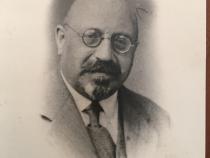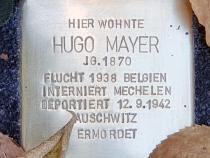Biography
Hugo Mayer
Place of laying: Barbarossastr. 32
District: Charlottenburg-Wilmersdorf, Wilmersdorf
Relocation date: xx.xx.xxxx
Born: 03.05.1870 in Bernkastel (Mosel)
Deportation: 12.09.1942 from the collection camp in Mechelen (Malines), Belgium, via Koźle (Kozel) to the concentration camp in Auschwitz-Birkenau
Death: murdered
Hugo Mayer was born on 03.05.1870 in Bernkastel an der Mosel. He was the youngest child of Leo and Marianne Mayer, who had married in Bernkastel on 10/28/1859 and was buried in the Jewish cemetery in Bernkastel in 1909.
Hugo Mayer married Selma Mayer, née Giesenow, in Berlin on 11/17/1903 (see biography of Selma Mayer). They lived in an apartment at Barbarossastr. 32 in Berlin Wilmersdorf. Their daughter Helene Mayer was born in Berlin on Oct. 9, 1904.
Hugo Mayer was a merchant and owned a metal goods factory and stamping shop since 1906, initially at Oranienstrasse 34. In the 1920s, the "Metallwarenfabrik und Stanzerei Hugo Mayer" moved to Köpenickerstrasse 114 in Berlin-Luisenstadt (now Kreuzberg); it was registered in the Commercial Register under 91 HRA 72960 on August 29, 1928. Hugo Mayer was the sole owner of the factory, which produced pressed, drawn, stamped articles using electroplating and soldering eyelet tinning, as well as increasingly producing components and accessory parts for the emerging radio and broadcasting industry.
Hugo Mayer's factory covered a few 100 square meters and was modernly equipped for the time with machine tools, milling machines, and lathes of various sizes. A catalog first published in 1926 included about 750 items for the radio and electrical industries. In the early 1930s, more than 80 workers were employed in the office, as well as numerous clerks. The customers of this widely known specialized company headed by Hugo Mayer in Germany included AEG, Siemens, Telefunken, Bosch, i.e. Hugo Mayer's factory was an important supplier for the entire German radio industry. In addition, the factory exported its specialized products to other European countries. His wife Selma Mayer played a major role in the factory management. She handled commercial matters on her own responsibility and had power of attorney.
From 1933 onwards, Hugo and Selma Mayer, as Jews, as well as the company, were increasingly subjected to harassment by the national socialists due to their Jewish ownership, so that Hugo Mayer was forced to sell the factory on July 28, 1936. The money of the purchase price was immediately blocked by the tax office Berlin-Schöneberg.
The daughter Helene Mayer emigrated without her parents to Palestine, today's Israel, in 1936. Hugo and Sema Mayer could not imagine leaving for Palestine because they saw insurmountable difficulties in rebuilding their factory there. Instead, in 1938, they emigrated as political refugees via Italy to Brussels, Belgium. There Hugo Mayer hoped to establish a new factory. However, he and his wife Selma were arrested in Brussels, which was occupied by the national socialists- because they were Jews, and on Sept. 10, 1942, they were taken to the assembly camp at the Dossin barracks in Mechelen (Malines), Belgium. On 12.09.1942 they were deported by the national socialists from the assembly camp with transport IX to Koźle (Kozel), today Poland, and from there to Auschwitz-Birkenau.
There are no documents on the death of Hugo Mayer. Hugo and Selma Mayer were declared dead by the district court of Berlin-Schöneberg with the date 21.12.1942. In view of his advanced age, there is much to suggest that he - should he have survived the transport - was murdered immediately after arrival in Auschwitz-Birkenau on 14.09.1942.




